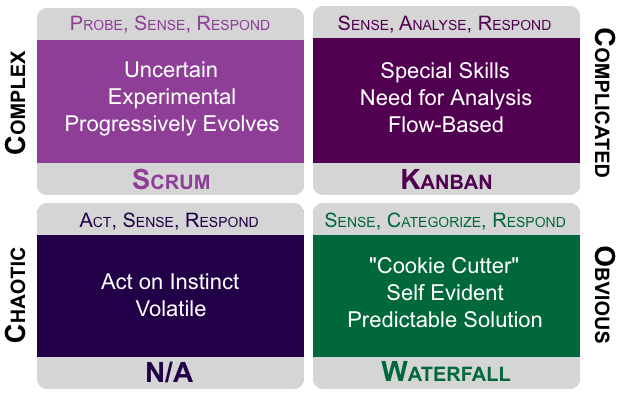“We are going agile!” This seems to be a statement often used in an effort to streamline existing business practices in favor of more efficient and customer-focused processes. However, before we make a paradigm shift in our day to day business activities, it is important to recognize the context in which we currently situate ourselves, and make the right decisions based on that context.
EK’s agile approach to Knowledge Management (KM) yields the benefits of rapid implementation of KM solutions, such as a taxonomy design, content strategy, or team collaboration planning, all of which yield results within weeks or months, rather than years. However, an agile approach is not the right approach for every KM project.
The Cynefin Framework
Originally established as a sense-making framework, Dave Snowden’s Cynefin Framework (pronounced Kih-neh-vihn), is a Welsh term loosely meaning “habitat.” The framework helps us visualize and understand that not all situations and/or challenges are created equally. Therefore, different solutions are warranted depending on the context of the scenario. Applying the framework helps us place ourselves in the right scenarios or “habitats,” so that we can pair the right approach with our corresponding situation to achieve optimal outcomes. Using this framework can help us make sense of the context we are in so that we can not only make better decisions, but also avoid the problems that arise when our preferred management style causes us to make mistakes.
Cynefin consists of five domains: two of ‘order’ (the obvious and complicated), two of ‘un-order’ (complexity and chaos) and one of ‘disorder,’ similar to the one below:
Obvious – Here we know what we are doing and have seen it a thousand times before, so we sense, categorize and respond. Often the domain of known cause and effect, here we expect to see best practices employed. The waterfall project management technique is often used in this domain. For example, here at Enterprise Knowledge, we have a standard approach to taxonomy design. While all projects are customized and vary greatly in size and complexity, our taxonomy design methodology is well-established and a similar approach can often be used.
Complicated – When a situation is complicated, we don’t know what is going on but know that we can analyze what has happened and work it out, so we are sensing, analysing and responding. Often an expert can be used here to analyze and provide an opinion; this is the domain of good practice, where the agile practice of Kanban is often a successful management strategy. Knowledge Management strategy and roadmapping generally falls into this category. Although certain aspects of the approach are standard (e.g., interviews, documentation reviews), much of the work leverages our expertise across a variety of KM factors to deliver a current and target state that is tailored and unique to the organization’s needs.
Complex – Here, the relationship between cause and effect can only be understood in retrospect and the results are unpredictable. We cannot determine what will cause a particular outcome but we can run some experiments to see if they move us in the right direction so we probe, sense and respond. This is also the domain of multi-hypothesis as there is no right or wrong answer so we may want to run a series of experiments or in fact run a number in parallel. This is the domain of emergent practice and is often the domain where the agile practice of scrum is utilized. Knowledge Management system recommendations during KM Strategy projects generally fall in this domain. Here, we need to test if a recommended system and design – for example an expert finder or community of practice – will work for the specifics laid out by the client. Therefore, we build prototypes using a recommended system to see if it moves us in the right direction.
Chaotic – Here the system is not stable but we need to do something as it is not viable to just wait, so we quickly act, then sense and respond. Chaos is a transitory state that is often difficult to maintain for any length of time. However, problems in this domain are often solved by the implementation of new and innovative solutions. Problems or issues in the chaotic domain will require you to act first, then sense and respond. Issues in this domain may include a restructuring of the organization, budget reallocations, or even a sweeping change in technology or business requirements.
Disorder– Problems get placed into this category when we have yet to place them in one of the other four. These uncategorized problems are oftentimes harmful to the company and should be de-escalated and guided into one of the other four categories for management.
In Conclusion
The Cynefin Framework gives us a model to select the right project management approach for the current reality of each of our clients. Rather than taking a cookie-cutter approach to project management, we adjust our management style to fit your circumstances.
When you’re ready to step up to your organization’s Knowledge Management challenges, EK will create a custom approach – not just to your KM strategy and technical implementation – but also to the project management style which will best enable the success of your KM project. Contact us for more information.

